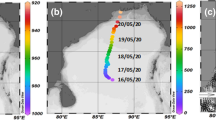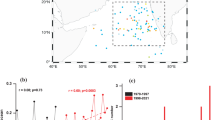Abstract
This study investigates the rapid weakening of super-cyclone Amphan (2020) over the Bay of Bengal. Shortly after reaching its super-cyclone status, Amphan experienced rapid weakening. Satellite and in-situ observations are used to ascertain the influence of local sea surface temperature changes on the weakening of Amphan. Results showed that the onset of rapid weakening was triggered by its passage over the cold wake of amplitude ~ 1.5 °C induced by the cyclone itself. Analysis showed that the cooling started 2 days ahead of the actual arrival of the cyclone over this region. This ahead-of-the-eye cooling occurred in the right frontal region of the track spanning a horizontal scale of ~ 200 km. The large size of the Amphan and its slow translation speed (2 m/s) facilitated sea surface cooling ahead of its arrival. The shallow mixed layer (20 m) prevailed at this region enhanced cooling through vertical mixing. The analysis of the sea surface temperature shows that the ahead-of-the-eye cooling (1.5 °C) accounts to 39% of the total cooling (4 °C) induced by Amphan over the cold wake region. As the sea surface cooled, the latent and sensible heat fluxes dropped by 42% over the cold wake region reducing the energy supply to the cyclone. Thus, the negative feedback induced by the ahead-of-the-eye cooling contributed to the rapid weakening of super-cyclone Amphan over Bay of Bengal. This study presents for the first time in Indian Ocean, the intensity reduction of a super-cyclone after its passage over its own cold wake. The results presented here based on a real cyclone case point towards the importance of realistic representation of oceanic factors such as variations in the real-time local sea surface temperature and mixed layer depths. This is essential for the accurate forecasting of changes in the intensity of cyclones.












Similar content being viewed by others
Data availability
All the data used in this study are publicly available, and the corresponding sources are mentioned in the manuscript.
References
Ali MM, Jagadeesh PSV, Jain S (2007) Effects of eddies on Bay of Bengal cyclone intensity. EOS Trans Am Geophys Union 88:93–95
Bender MA, Ginis I, Kurihara Y (1993) Numerical simulations of tropical cyclone–ocean interaction with a high-resolution coupled model. J Geophys Res 98:23245–23263
Bender MA, Ginis I (2000) Real-case simulations of hurricane ocean interaction using a high-resolution coupled model: effects on hurricane intensity. Mon Weather Rev 128:917–943
Bhalachandran S, Nadimpalli R, Osuri KK, Marks F Jr, Gopalakrishnan SG, Subramanian S, Mohanty UC, Niyogi D (2019) On the processes influencing rapid intensity changes of tropical cyclones over the Bay of Bengal. Sci Rep 9:3382. https://doi.org/10.1038/s41598-019-40332-z
Busireddy NKR, Ankur K, Osuri KK, Sivareddy S, Niyogi D (2019) The response of ocean parameters to tropical cyclones in the Bay of Bengal. Q J R Meteorol Soc 145:3320–3332. https://doi.org/10.1002/qj.3622
Cione JJ, Uhlhorn EW (2003) Sea surface temperature variability in hurricanes: implications with respect to intensity change. Mon Weather Rev 131:1783–1796
Chacko N (2017) Chlorophyll bloom in response to tropical cyclone Hudhud in the Bay of Bengal: bio-argo subsurface observations. Deep Sea Res Part I 1(124):66–72. https://doi.org/10.1016/j.dsr.2017.04.010
Chacko N, Zimik L (2018) Effect of cyclone Thane in the Bay of Bengal explored using moored buoy observations and multi-platform satellite data. J Indian Soc Remote Sens 46:821–828. https://doi.org/10.1007/s12524-017-0748-9
Chacko N (2019) Differential chlorophyll blooms induced by tropical cyclones and their relation to cyclone characteristics and ocean pre-conditions in the Indian Ocean. J Earth Syst Sci 128:177. https://doi.org/10.1007/s12040-019-1207-5
Chacko N, Jayaram C (2021) Response of the Bay of Bengal to super cyclone Amphan examined using synergistic satellite and in-situ observations. Oceanologia 64(1):131–144. https://doi.org/10.1016/j.oceano.2021.09.006
Chan KTF, Chan JCL (2015) Global climatology of tropical cyclone size as inferred from QuikSCAT data. Int J Climatol 35(15):4843–4848. https://doi.org/10.1002/joc.4307
Chan JCL, Gray WM (1982) Tropical cyclone movement and surrounding relationships. Mon Weather Rev 110:1354–1374
Chen LS, Xu XD, Luo ZX, Wang JZ (2002) Introduction to tropical cyclone dynamics. Meteorol Press, pp 317
Clayson CA, Jeremiah B, Program NOAACDR (2016) NOA climate data record ocean surface bundle (OSB) Climate Data Record (CDR) of Ocean Heat Fluxes, version 2. NOAA Natl Clim Data Center. https://doi.org/10.7289/V59K4885
Colomb A, Kriat T, Leroux MD (2019) On the rapid weakening of very intense tropical cyclone Hellen (2014). Mon Weather Rev 147(8):2717–2737. https://doi.org/10.1175/MWR-D-18-0309.1
DeMaria M, Kaplan J (1994) A Statistical Hurricane Intensity Prediction Scheme (SHIPS) for the Atlantic basin. Weather Forecasting 9:209–220
Emanuel K (2003) Tropical cyclones. Annu Rev Earth Planet Sci 31:75–104
Emanuel KA (1999) Thermodynamic control of hurricane intensity. Nature 401:665–669. https://doi.org/10.1038/44326
Glenn SM, Miles TN, Seroka GN et al (2016) Stratified coastal ocean interactions with tropical cyclones. Nat Commun 7:10887. https://doi.org/10.1038/ncomms10887
Holliday CR, Thompson AH (1979) Climatological characteristics of rapidly intensifying typhoons. Mon Weather Rev 107:1022–1034
Jacob SD, Shay LK, Mariano AJ, Black PG (2000) The 3D oceanic mixed layer response to Hurricane Gilbert. J Phys Oceanogr 30:1407–1429
Jaimes B, Shay LK (2009) Near-inertial wave wake of Hurricanes Katrina and Rita over mesoscale oceanic eddies. J Phys Oceanogr 40:1320–1337
Jaiswal N, Ha DTT, Kishtwal CM (2019) Estimation of size of tropical cyclones in the North Indian Ocean using Oceansat-2 scatterometer high-resolution wind products. Theoret Appl Climatol 136:45–53. https://doi.org/10.1007/s00704-018-2464-y
Jullien S, Christophe M, Patrick M, Jourdin NC et al (2012) Impact of tropical cyclones on the heat budget of the South Pacific Ocean. J Phys Oceanogr 42(11):1882–1906. https://doi.org/10.1175/JPO-D-11-0133.1
Jullien S, Marchesiello P, Menkes CE et al (2014) Ocean feedback to tropical cyclones: climatology and processes. Clim Dyn 43:2831–2854. https://doi.org/10.1007/s00382-014-2096-6
Kaplan J, DeMaria M (2003) Large scale characteristics of rapidly intensifying tropical cyclones in the North Atlantic Ocean. Weather Forecasting 18:1093–1108
Kuttippurath J, Sunanda N, Martin MV (2021) Tropical storms trigger phytoplankton blooms in the deserts of north Indian Ocean. npj Clim Atmos Sci 4:11. https://doi.org/10.1038/s41612-021-00166-x
Kuttippurath J, Akhila RS, Matin MV, Girishkumar MS, Mohapatra M, BalanSarojini B, Mogensen K, Sunanda N, Chakraborty A (2022) Tropical cyclone-induced cold wakes in the northeast Indian Ocean. Environ Sci Atmos 2:404–415
Leipper D, Volgenau D (1972) Hurricane heat potential of the Gulf of Mexico. J Phys Oceanogr 2:218–224
Lin II, Chen CH, Pun IF, Liu WT, Wu CC (2008) Warm ocean anomaly, air sea fluxes, and the rapid intensification of tropical cyclone Nargis (2008). Geophys Res Lett L0381. https://doi.org/10.1029/2008GL03581
Lin II, Chen CH, Pun IF, Liu WT, Wu CC (2009) Warm ocean anomaly, air sea fluxes, and the rapid intensification of tropical cyclone Nargis (2008). Geophys Res Lett 36:L03817
Lin II (2012) Typhoon-induced phytoplankton blooms and primary productivity increase in the western North Pacific subtropical ocean. J Geophys Res 117:C03039
Lin II, Goni GJ, Knaff JA, Forbes C, Ali MM (2013) Ocean heat content for tropical cyclone intensity forecasting and its impact on storm surge. Nat Hazards 66:1481–1500. https://doi.org/10.1007/s11069-012-0214-5
Lloyd ID, Vecchi GA (2011) Observational evidence for oceanic controls on hurricane intensity. J Climate 24:1138–1153. https://doi.org/10.1029/2011JC007626
Lu X, Yu H, Yang X, Li X (2017) Estimating tropical cyclone size in the northwestern Pacific from geostationary satellite infrared images. Remote Sensing 9(7):728. https://doi.org/10.3390/rs9070728
Mei W, Pasquero C, Primeau F (2012) The effect of translation speed upon the intensity of tropical cyclones over the tropical ocean. Geophys Res Lett 39:L07801. https://doi.org/10.1029/2011GL050765
Mei W, Lein CC, Lin II, Xie SP (2015) Tropical cyclone induced ocean response: a comparative study of the South China Sea and tropical Northwest Pacific. J Clim 28:5952–5968. https://doi.org/10.1175/JCLI-D-14-0065.11
Mohanty UC, Nadimpalli R, Mohanty S (2021) Understanding the rapid intensification of tropical cyclone Titli using Hurricane WRF model simulations. Mausam 72(1):167–176
Nadimpalli R, Mohanty S, Pathak N et al (2021) Understanding the characteristics of rapid intensity changes of Tropical Cyclones over North Indian Ocean. SN Appl Sci 3:68. https://doi.org/10.1007/s42452-020-03995-2
Paterson LA, Hanstrum BN, Davidson NE, Weber HC (2005) Influence of environmental vertical wind shear on the intensity of hurricane-strength tropical cyclones in the Australian Region. Monthly Weather Rev 3644–3660. https://doi.org/10.1175/MWR3041.1
Price JF (1981) upper ocean response to a hurricane. J Phys Oceanogr 11:153–175
Qian Y, Zhang S (2013) Cause of rapid weakening of Typhoon Bebinca (0021) in the South china Sea. Trop Cyclone Res Rev 2:159–167. https://doi.org/10.6057/2013TCRR03.03
Rao RR, Sivakumar R (2003) Seasonal variability of sea surface salinity and salt budget of the mixed layer of the north Indian Ocean. J Geophys Res 108:C13009
Rajasree VPM, Bhate Jyoti N, Kesarkar Amit P, Singh V (2021) Genesis and rapid weakening of tropical cyclone Lehar (2013). Nat Hazards 1573–0840. https://doi.org/10.1007/s11069-021-04840-4
Reul N, Tenerelli J, Chapron B, Vandemark D, Quilfen Y, Kerr Y (2012) SMOS satellite L-band radiometer: a new capability for ocean surface remote sensing in hurricanes. J Geophys Res 117:C02006. https://doi.org/10.1029/2011JC007474
Reynolds RW, Smith TM, Liu C, Chelton DB, Casey KS, Schlax MG (2007) Daily High-Resolution-Blended Analyses for Sea Surface Temperature. J Climate 20:5473–5496. https://doi.org/10.1175/2007JCLI1824.1
Schade LR, Emanuel KA (1999) The ocean’s effect on the intensity of tropical cyclones: Results from a simple coupled atmosphere ocean model. J Atmos Sci 56:642–651. https://doi.org/10.1175/1520-0469(1999)056%3c0642:TOSEOT%3e2.0.CO;2
Seroka GN, Miles TN, Xu Y, Kohut JT, Schofield O, Glenn SM (2016) Hurricane Irene sensitivity to stratified coastal ocean cooling. Mon Weather Rev 144(9):3507–3530. https://doi.org/10.1175/MWR-D-15-0452.1
Shay LK, Goni GJ, Black PG (2000) Role of a warm ocean feature on Hurricane Opal. Mon Wea Rev 128:1366–1383
Singh VK, Roxy MK (2022) A review of ocean-atmosphere interactions during tropical cyclones in the north Indian Ocean. Earth Sci Rev 226:103967
Sutyrin GG, Khain AP (1984) Effect of the ocean–atmosphere interaction on the intensity of a moving tropical cyclone. Atmos Oceanic Phys 20:787–794
Wang Y, Wu CC (2004) Current understanding of tropical cyclone structure and intensity changes-a review. Meterolo Atmos Phys 87:257–278. https://doi.org/10.1007/s00703-003-0055-6
Whitney LD, Hobgood JS (1997) The relationship between sea surface temperatures and maximum intensities of tropical cyclones in the Eastern North Pacific Ocean. J Clim 10:2921–2930
Wood KM, Ritchie EA (2015) A definition for rapid weakening of North Atlantic and Eastern North Pacific tropical cyclones. Geophys Res Lett 42:10–9
Wu CC, Lee CY, Lin II (2007) The effect of the ocean eddy on tropical cyclone intensity. J Atmos Sci 64(10):3562–3578. https://doi.org/10.1175/JAS4051.1
Ye HJ, Sui Y, Tang DL, Afanasyev YD (2013) A subsurface chlorophyll a bloom induced by typhoon in the South China Sea. J Mar Syst 128:138–145. https://doi.org/10.1016/j.jmarsys.2013.04.010
Yu J, Lin S, Jiang Y, Wang Y (2021) Modulation of typhoon-induced sea surface cooling by preexisting eddies in the South China Sea. Water 13(5):653. https://doi.org/10.3390/w13050653
Zeng Z, Wang Y, Wu CC (2007) Environmental dynamical control of tropical cyclone intensity - an observational study. Mon Weather Rev 135:38–59
Acknowledgements
These Argo data were collected and made freely available by the International Argo Program and the national programs that contribute to it. (http://www.argo.ucsd.edu, http://argo.jcommops.org). The Argo Program is part of the Global Ocean Observing System. Moored buoy data is provided by the Indian National Centre for Ocean Information Services (INCOIS) and their support for providing data is greatly appreciated. I also thank the Ocean Observation Programme of the National Institute of Technology (NIOT), Chennai, for the deployment and maintenance of the moored buoy. The NOAA National Center for Environmental Information Climate Data Record is highly thanked for providing latent and sensible heat fluxes. SMAP sea surface wind data are produced by Remote Sensing Systems and sponsored by NASA Earth Science funding. Data are available at www.remss.com/missions/SMAP/winds.
Author information
Authors and Affiliations
Corresponding author
Ethics declarations
Conflict of interest
The author declares no competing interests.
Additional information
Responsible Editor: Swapna Panickal
Rights and permissions
Springer Nature or its licensor (e.g. a society or other partner) holds exclusive rights to this article under a publishing agreement with the author(s) or other rightsholder(s); author self-archiving of the accepted manuscript version of this article is solely governed by the terms of such publishing agreement and applicable law.
About this article
Cite this article
Chacko, N. On the rapid weakening of super-cyclone Amphan over the Bay of Bengal. Ocean Dynamics 73, 359–372 (2023). https://doi.org/10.1007/s10236-023-01555-x
Received:
Accepted:
Published:
Issue Date:
DOI: https://doi.org/10.1007/s10236-023-01555-x




